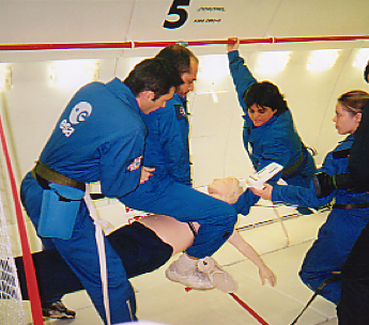In larger spaces, where they cannot brace against walls, astronauts must revert to what is known as the Evetts-Russomano technique. "This is where the patient float freely and the other person sits on their chest." This method does not give as deep a compression, but does give a higher number per minute - The Times, 5th June, 2017  Thais Russomano and team on a European Space Agency (ESA) parabolic flight campaign Thais Russomano and team on a European Space Agency (ESA) parabolic flight campaign The Team are delighted to see posted in The Times newspaper (London, UK - 05/06/2017) an article regarding the performance of cardiopulmonary resuscitation (CPR) in space, mentioning a technique conceived and developed by InnovaSpace Founder and Director Thais Russomano, in conjunction with two space colleagues Lisa and Simon Evetts. CPR is a well-known emergency procedure here on Earth, administered to someone whose heart has stopped beating. Chest compressions are performed to try and manually pump blood through the heart, brain and body. Not too difficult to perform on Earth, with a little training, but is it the same in Space? On Earth the weight of our bodies is used to perform the compressions of the chest – but in space our body weighs nothing! To be more precise, we are in a state of weightlessness. Therefore, in space, giving chest compressions depends more on the force and strength of the upper body muscles of the person providing the CPR. Another problem to overcome in space is that everything is floating - including you and the person with no heart beat. Try to compress the chest as you would on Earth and the force you apply will generate a reaction force in the opposite direction (Newton’s Laws of Motion) – simply put, when you push down onto the chest you will float away from the person you are trying to help! To overcome this, scientists have developed some techniques to allow effective CPR to be given in space – the three main methods being the Handstand, Reverse Bear Hug and Evetts-Russomano. Using the Evetts-Russomano technique, the rescuer performing the CPR wraps their left leg over the right shoulder of the stricken person, and their right leg wraps around the person's torso, allowing ankles to be crossed at the back to aid muscular stability. From this position, chest compressions can be performed. The short video clip seen below, taken in 2000, gives a better demonstration of the procedure being performed in the microgravity provided by a parabolic flight. Dr. Russomano and her extraterrestrial CPR research group have been studying the best methods for administering this life saving technique in simulated hypogravity and microgravity conditions for almost two decades and are the team with the greatest number of scientific publications in this area. More people are predicted to fly into space over the coming years with the advent of space tourism and manned missions to Mars, leading to the likelihood that more serious medical incidents will occur and, therefore, lives could be saved through knowing how to correctly administer CPR in space.
Written by Mary Upritchard
1 Comment
Adriana Bos Mikich
25/3/2018 05:19:10 pm
Very good!
Reply
Your comment will be posted after it is approved.
Leave a Reply. |
Welcometo the InnovaSpace Knowledge Station Categories
All
|
InnovaSpace Ltd - Registered in England & Wales - No. 11323249
UK Office: 88 Tideslea Path, London, SE280LZ
Privacy Policy I Terms & Conditions
© 2024 InnovaSpace, All Rights Reserved
UK Office: 88 Tideslea Path, London, SE280LZ
Privacy Policy I Terms & Conditions
© 2024 InnovaSpace, All Rights Reserved

 RSS Feed
RSS Feed